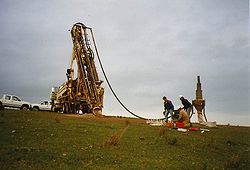Exploration (geology)
In mining and geology , exploration refers to the search for or the development (precise investigation) of deposits and raw material deposits in the earth's crust. Exploration geology is a sub-area of deposit science within the geosciences .
Historically, exploration can be seen as one of the essential precursors of geological research, as a large number of mineral resources have been more or less systematically developed and exploited for several thousand years. An example of this are the coal deposits emerging from the sea , which were exploited very early in human history.
The main areas of exploration in exploration geology are deposits and occurrences of:
From a methodological point of view, the development of groundwater can also be viewed as a task of exploration geology, since it is also a natural (albeit mostly renewable) raw material.
When exploring a deposit, exploration follows the prospecting phase . In this first only one area of courtship was identified, which justified further investigations. Now the actual development begins with the delineation of the localized deposit. The geological framework is now known, the risk that the previous investments and the work involved were in vain is only approx. 50%. The investigations started during the prospecting ( geological mapping , sampling in pits and boreholes , chemical and mineralogical - petrographic analyzes) will be systematically continued and expanded. At the end of this phase, it should be possible to estimate the dimensions of the deposit, as well as an initial calculation of the reserves. On the basis of this data, a decision must be made as to whether further development of the deposit makes sense or not.
Exploration geologists have a wide range of scientific methods at their disposal, in which almost all geological sciences are applied
- geophysical methods ( gravimetry , geoseismics , geomagnetics , geoelectrics , borehole geophysics, etc.)
- tectonic and structural geological analyzes
- paleontological analyzes (e.g. stratification of drill cores)
- geochemical analysis for the determination of enrichment values
- Geoinformatics (tectonic analyzes, development of exploitation strategies and visualization)
The deposit is now proven. The exploration work will be complemented by technical tests (testing of the metallurgical treatment, sometimes experimental mining), and find with the feasibility study ( feasibility-study ) their preliminary statements. For the entire exploration of a deposit, periods of five to ten years are expected. If the profitability study prepared within the scope of mining economics turns out to be positive, the actual mining can begin. In parallel, exploration continues in the lesser-known parts of the deposit.
In addition to the exploitation of deposits, exploration geologists are now increasingly employed in the processing of environmental damage, as scientific work in environmental geology is similar to that in exploration geology .
Ores
| Mineral / metal | Exposure color | Minerals in the outcrop |
|---|---|---|
| Iron sulfides | Yellow, brown, red | Goethite , hematite , limonite , iron sulfate |
| manganese | black | Manganese oxides |
| antimony | White | Antimony flower |
| arsenic | Greenish, yellowish | Iron arsenate |
| bismuth | Light yellow | Bismuth ocher |
| cadmium | Light yellow | Cadmium sulfide |
| Cobalt | Black, purple | Erythrin , cobalt oxides |
| copper | Green Blue | Copper minerals |
| lead | White yellow | Cerussite , Anglesite , Pyromorphite |
| mercury | red | cinnabar |
| molybdenum | Light yellow | Molybdenum oxides , iron molybdate |
| nickel | green | Annabergite , Garnierite |
| silver | Green yellow | solid silver |
| uranium | Light green, yellow | Torbernit , autunit |
| Vanadium | Green yellow | Vanadates |
| zinc | White | Zinc spar |
See also
literature
- FW Prokop, W. Streck, M. Sagher, RW Tschoepke, HW Walther, H. Pietzner, G. Stadler, H. Vogler, H. Werner: Investigation and evaluation of deposits of ores, usable minerals and rocks (Vademecum 1) . 2nd edition, Geological State Office North Rhine-Westphalia, Krefeld, 1981.
- Charles J. Moon, Michael KG Whateley & Anthony M. Evans (Eds.): Introduction to Mineral Exploration . 2nd Edition. Blackwell, 2006, ISBN 1-4051-1317-0 , pp. 80 .
